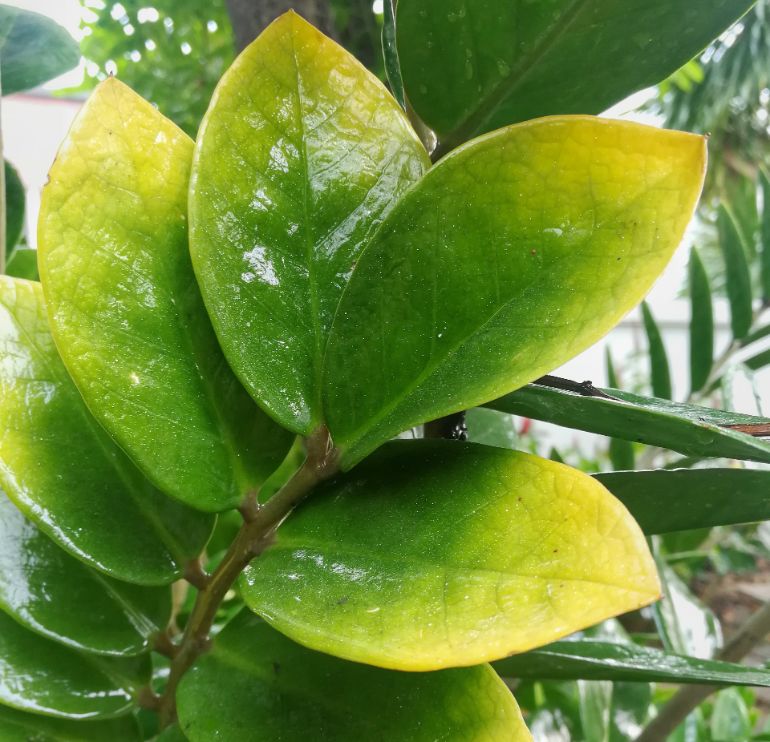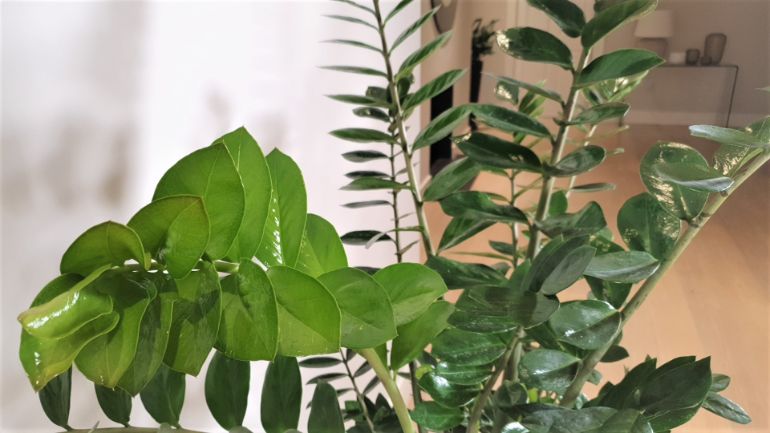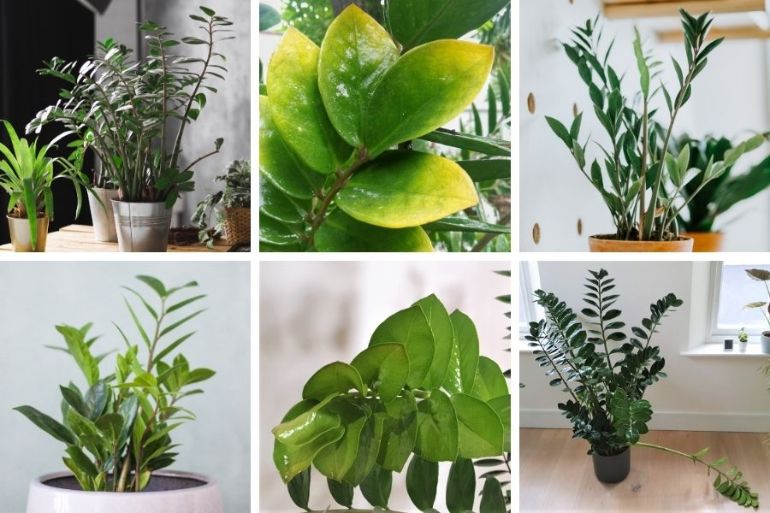ZZ plants make delightful houseplants, with glossy green leaves and interesting upright, curving stems. They are notoriously tolerant of neglect, but this doesn’t make them indestructible. This article is going to cover all of the common ZZ plant problems, as well as how to fix and prevent them.
The most common ZZ Plant problems are yellow leaves and root rot caused by overwatering. They are also prone to brown leaves due to excess light, heat, overfertilizing, or low humidity. Bright, indirect light, well-draining soil, and cautious watering will prevent most problems.
I’m going to cover each of the common problems you may experience with your ZZ plant and try to help you get your plant thriving again.
1. ZZ Plant Leaves Turning Yellow
Yellow leaves on ZZ Plants are most commonly due to overwatering. This tends to happen to lower and older leaves first and may be accompanied by brown leaf tips, lack of growth, drooping stems, and wrinkled leaves if severe. Yellow leaves can also be due to excessive sunlight, pests, acclimation, or temperature stress.
To work out why your ZZ Plant has this problem, consider the following.
- Overwatering is the most common cause of yellow leaves, so check this first.
- Look for other signs of overwatering – Early signs include leaf yellowing and edema. As root rot sets in, you may see drooping stems, brown leaf tips, especially on younger leaves, wrinkled leaves, and you may smell the offensive odor of rotting roots.
- ZZ plant leaves will scorch and turn yellow/brown in excess light. If your ZZ plant is getting a lot of direct sunlight per day, leaf scorching, rather than overwatering is a more likely cause of this ZZ plant problem.
- Irregular yellow spots on your ZZ plant are quite often caused by pests, as they feed on the foliage. Carefully inspect both sides of the leaves and stems for any signs of pests.
- Newly purchased ZZ plants often go through an acclimation process. They can develop some yellow leaves or even some leaf drop as it adjusts to the conditions in your home.
- Read more about the causes of yellow leaves on ZZ plants here.

2. Your ZZ Plant Isn’t Growing New Leaves
If your ZZ plant is not growing new leaves, the most likely cause is insufficient light. ZZ plants prefer bright, indirect light. Cool temperatures or any other cause of stress can also result in your ZZ plant not growing.
The growing season for ZZ plants in most climates is from early spring to mid-autumn. This is largely dictated by lighting conditions, so you can extend the growing season by using grow lights. ZZ plants will normally grow all year round in equatorial climates.
If your ZZ plant is getting plenty of light, the next thing to consider is whether there are any other ZZ plant problems causing your plant stress and inhibiting growth. Here are a few things to look out for:
- Is your ZZ plant root-bound? If you haven’t repotted your ZZ plant in many years, the roots will have grown to fill the pot, and there may not be any more room to grow. Your plant may not be keen on growing new shoots and leaves without growing sufficient roots to support this. If you see roots growing out the drainage holes, and your plant looks like it is bursting out of the pot, repot in a slightly bigger pot to promote new growth.
- Fertilizer issues can prevent growth. Overfertilizing your ZZ plant can damage the roots, preventing new growth. ZZ plants only need to be fertilized a few times per year for optimal growth. Consider flushing the soil if you think you may have overfertilized. Very rarely, if a ZZ plant is growing in very nutrient-deficient soil, this can prevent new growth. If your ZZ plant hasn’t been fertilized or repotted for many years, consider adding a little fertilizer to stimulate growth.
- Acclimation can prevent your ZZ plant from growing. Bear in mind that it can take 4-6 weeks for a ZZ plant to adjust to the conditions in your home, and may not produce any growth during this time. Provide comfortable conditions for your plant, and it will soon start growing.
- Other sources of stress, such as drafts, pests, or disease can all prevent a ZZ plant from growing new leaves. Inspect your plant and the surroundings carefully for any signs of problems, and deal with each issue as you find it.
If you’re still not sure what is preventing your ZZ plant from growing, you can read this article which covers the main issues, along with 5 top tips to help your ZZ plant grow faster.
3. Your ZZ Plant Has Brown Tips
Brown tips on ZZ plants are most commonly due to overwatering, particularly if seen on new growth. Underwatering, excess heat or light, overfertilizing, or low humidity can also cause brown tips on ZZ plant leaves due to dehydration.
The tips of the leaves are the most sensitive part of the plant to a deficiency of water, resulting in the leaf tips dying and turning brown. Excess water loss from the leaves or an inability to provide enough water to the leaves will result in brown leaf tips.
Overwatering is the most common cause of brown tips on ZZ plants, which may not seem to make sense when you first think about it. However, overwatering results in soggy soil, which damages or even kills the roots. Once this happens, water abundance transitions to water deficiency, and the already weakened plant develops brown tips on delicate new growth quite rapidly.
Here are a few other tips to identify the cause and prevent brown tips on ZZ plants.
Excessively low humidity – Monitor humidity in the room you keep your ZZ plant in. While the glossy leaves of ZZ plants don’t require high humidity to remain healthy, they can still develop brown tips if grown in arid conditions.
Hot or cold drafts from heating or cooling appliances, or from drafty windows – Make sure your plant is out of range of any of these things. I use a digital thermometer to monitor the temperature where I keep my houseplants. It keeps track of minimum, current, and maximum temperature, so it is useful to see at a glance whether my plant has been exposed to extremes.
Excess light – ZZ plants do best in bright, indirect light. Excess sunlight results in a lot more heat and water loss from the leaves. The roots often struggle to keep pace with the rate of water loss, and this will result in brown leaf tips.

4. New Growth On Your ZZ Plant Is Light Green
The new growth of a ZZ plant is normally light green and will slowly darken to match the color of the existing foliage over a period of several months. Occasionally, a nutrient-deficient ZZ plant can develop excessively light-colored new growth or may present with leaves that are not evenly green.
If the foliage is very thin and spindly or doesn’t darken in color over time, consider nutrient deficiency as a potential cause. Make sure the other areas of care are being addressed to ensure there is no other issue impeding growth.
5. The Root Bulb Of Your ZZ Plant Is Exposed
The root bulb or rhizome of a ZZ plant can become exposed over time due to soil getting washed away from repeated watering. The roots can also become exposed if your ZZ plant is becoming root-bound over time. An exposed rhizome/root bulb is not normally a sign of an unhealthy plant.
The roots of a ZZ plant can become exposed if you water your plant from the top. Some soil tends to get washed off the soil surface every time you water your plant. You can prevent this by adding a little water at a time or watering your plant from the bottom.
If the roots become exposed, it may also be a sign that your plant has become rootbound and needs to be repotted. You should gently slide your plant out of the pot and inspect the roots to see if they are tightly coiled around the inside of the pot. Repot if necessary to encourage healthy growth.
When potting your ZZ plant, fill the pot to the level of the base of the stems, so that the rhizome is just covered with soil. Avoid potting too deeply – Leaving a little root bulb exposed is better than burying the stems, as this can promote stem rot.
6. ZZ Plant Stalks Are Falling Over
The most common cause of ZZ plant stalks falling over is overwatering, which leads to soft, rotting stems, that are unable to support the weight of the rest of the stem. It can also happen to a plant grown in low light conditions, where the stems tend to grow tall and thin, reducing their strength.
The growth habit of a ZZ plant is to develop tall stems that curve slightly as they grow. New stems grow quickly and can reach 3-4 feet within one growing season. This can leave them vulnerable to toppling over whenever they are grown in suboptimal conditions.
You may also see ZZ plant stalks falling over due to the position of your plant relative to the light source. As most people grow ZZ plants with a horizontal source of light from a window, new growth tends to grow towards the light, curving away from the rest of the plant as it does so.
Over time, this can lead to the stems growing at a considerable angle, and they may topple over and break under their weight. The best remedy to this is to rotate your ZZ plant a little every few weeks to keep the growth as upright as possible. This will produce a healthier and more visually appealing plant, and the stalks won’t topple over.
Stalks falling over is a pretty common issue, and it can sometimes be a little tricky to determine if you have just been unfortunate, or if it is due to ZZ plant problems that need to be addressed. This article goes into more detail on why ZZ plant stalks fall over, and how you can prevent it.

7. ZZ Plant Leaves Are Curling
ZZ plant leaves curling is normally due to a lack of water available for the leaves to use. The leaves curl to reduce the surface area of the leaves and reduce the amount of water loss. Underwatering or overwatering, excess heat, pests, or very low humidity can all cause leaf curling.
Leaf curling will often be accompanied by brown leaf tips and drooping of the stems of your ZZ plant. It is crucial to work out whether your plant is losing too much water, or is not able to provide enough to the leaves. Without this information, it is really difficult to fix your plant.
Carefully examine the rest of your plant, along with the growing conditions, and you should spot further clues as to what the problem is. Here are some of the things I look for:
Check lighting – Excess direct sunlight will result in increased water loss, encouraging the plant to take steps to reduce water loss, such as curling the leaves.
Water – Look for signs of overwatering or underwatering. The treatments are polar opposites. Underwatering is simple to detect, but it’s easy to miss an overwatered ZZ plant, as once the roots are damaged, an overwatered plant will have many symptoms of water deficiency too.
Humidity – In very arid conditions, particularly when temperatures are warm, you may also see ZZ plant leaves curling. Place your ZZ plant somewhere cooler, and boost humidity by grouping your plants, using a humidity tray, humidifier, or try one of these methods.
Pests – Many pests like to feed on ZZ plants, sucking the juices from the leaves. This causes irregular leaf damage, yellow spots on the leaves, and signs of dehydration and stress. Check your plant closely for pests at least every few weeks, and isolate your plant immediately from any others.
8. Your ZZ Plant Has Wrinkled Stems
If your ZZ plant has a wrinkled stem, it is most likely to be deficient in water. This can be due to excess water loss from high temperatures, excess light, or low humidity, or lack of water, due to underwatering or root rot. You will likely see other symptoms of water deficiency, and you will need to look at the symptoms and care conditions in combination to work out the cause.
9. ZZ Plant Root Rot
Root rot is the most common of all ZZ plant problems. It is the result of a ZZ plant growing in waterlogged, poorly aerated soil. ZZ plants should only be watered once at least the top half of the soil feels dry. Prevent root rot by growing your plant in very well-draining soil, in porous pots with plenty of drainage holes, and ensuring adequate light.
It often comes as a surprise to people when they learn that roots need a steady supply of oxygen to survive. Whilst plants produce energy for their needs through photosynthesis, they also use oxygen to grow and function. Soggy or poorly draining soil quickly becomes oxygen-deficient, and this puts the roots under extreme stress.
While the initial symptoms are related to an abundance of water, as they become increasingly stressed, they start to die off or succumb to opportunistic pathogens in the soil. This leads to rotting of the roots, which can spread to the stems of your ZZ plant.
While you can fix a ZZ plant that is experiencing the early signs of root rot, a more severe case is often fatal for your plant. Here are the symptoms to look for:
- Yellowing leaves, particularly affecting lower and older leaves.
- Leaf blisters or signs of edema.
- Brown leaf tips, particularly affecting newer growth.
- Leaf curling and wrinkled stems, as the roots start to be unable to deliver sufficient water to the plant.
- Stems falling over or drooping as they dehydrate or become rotten.
- A rotting smell from the roots becoming noticeable.
Having identified this problem, here is how to fix your plant and prevent it;
- Remove your ZZ plant from its pot.
- Loosen the soil and inspect the roots. Look for brown/black, mushy, fragile, smelly roots.
- Prune off all affected roots with sterile pruners.
- Wash the remaining soil off the roots. It is best to use new soil when repotting as the bugs that caused the root rot are likely still present in the soil.
- Pick a clean, porous pot that is just big enough for your plant and repot in a well-draining potting mix. Equal parts coco-coir and perlite, with about 10% compost or worm castings is a great option. As long as it drains really well, you won’t go too far wrong.
- Keep your ZZ plant in moderate light and temperatures. Water once at least the top half of the soil feels dry.
- It will take several months for the root system to recover before you will see any new growth, but hopefully, your plant will start producing new shoots before long.
- Read this article about identifying, treating, and preventing root rot for more info.
How To Prevent ZZ Plant Problems
Overwatering is by far the most common and serious ZZ plant problem, so if you avoid this, you’re halfway to having a healthy plant. The best way to avoid problems is to make sure your plant is growing in comfortable conditions, as well as checking your plant regularly to ensure it is healthy and its needs are being met.
Everyone makes mistakes when learning to grow houseplants and it’s part of the learning process. The best thing you can do is try to understand what happened to your plant, as this will help you to prevent the same issue the next time.
Hopefully, I’ve given you some helpful tips to fix most ZZ plant problems in this article. If you’d like to read more, this website is full of helpful articles about how to grow houseplants and fix common issues with their care. I’ve listed a few articles below that you may find interesting.
If you’d really like to get better at caring for houseplants, you should check out my book, “Houseplants Made Easy”. It covers everything you need to know to go from having a brown thumb, to effortlessly growing beautiful plants that thrive year after year.

